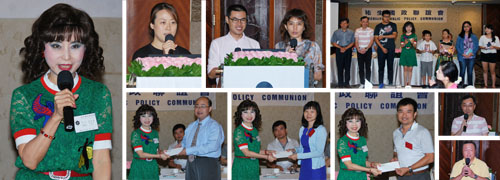Sketch of Public Policy Communion, August 2016
|
2016年8月份國政聯誼會縮影  本會已於2016年8月14日假台北喜來登大飯店地下二樓喜廳舉行「祐生國政聯誼會」。在主持人黃晉英秘書長宣布後揭開當日活動序幕,在輕鬆、活潑的節目過後,隨即由主持人帶來重要訊息:「新政府上任以來,社會中潛藏的問題逐一浮現,而值此改革的時刻,希望可以藉由祐生國政委員提出各個面向的建言,能使社會趨於穩健的發展。而制訂任何方針,必須有足夠的智慧,所以祐生期盼成員們藉由互相交流的過程中,激盪出正確的決策與思維。另外,祐生仍持續觀測氣候異變所帶來的暴烈化影響,在日常生活中會出現許多突發狀況,因此,提醒大家仍以『保守、保守、再保守』為行事準則。」 The August Archilife Public Policy Communion of 2016 was held on August 14, 2016. After a series of relaxing and fun activities, Secretary General Huang Chin-ying made the following announcement, "After the new government took up office, latent problems in society emerged one after another. At this moment of reformation, we hope that the recommendations made by members of our Public Policy Committee can help to promote steady social development. We need to make policies wisely. Therefore, I hope that Archilife members can discover correct decisions and thinking through brain storming from mutual exchange. We keep observing the unexpected situations in everyday life caused by the impact of extreme weather brought by climate change. Also, may I remind you to keep our code of practice: conservative, careful, cautious."  緊接著進行專題演講,由國政會委員李書安先生主講「奈米物質安全衛生管理」。主講人首先說明物質的各向度在一百奈米以下可稱為奈米物質,主要由於其獨特的光學、磁、電的特性,可應用在光電及半導體產業。但學者發現奈米微粒可穿透血管,進入動物心肺後易造成肺發炎、損傷,氧化壓力指標上升,引發血管阻塞、心肌發炎及退化等各種症狀。因此,為防範奈米物質對於人體的危害,在職業安全衛生法中已將奈米物質納入規範,並出版奈米物質安全衛生管理技術手冊,讓勞工對於奈米物質資訊及處置方法有更詳盡認識,且加強對於危害物質使用的管理。 緊接著進行專題演講,由國政會委員李書安先生主講「奈米物質安全衛生管理」。主講人首先說明物質的各向度在一百奈米以下可稱為奈米物質,主要由於其獨特的光學、磁、電的特性,可應用在光電及半導體產業。但學者發現奈米微粒可穿透血管,進入動物心肺後易造成肺發炎、損傷,氧化壓力指標上升,引發血管阻塞、心肌發炎及退化等各種症狀。因此,為防範奈米物質對於人體的危害,在職業安全衛生法中已將奈米物質納入規範,並出版奈米物質安全衛生管理技術手冊,讓勞工對於奈米物質資訊及處置方法有更詳盡認識,且加強對於危害物質使用的管理。Next on the schedule was the keynote speech. First, Mr. Li Shu-an, presented a speech on the "Safety and Health Management of Nanomaterials". First, the speaker explained that a substance could be called a nanomaterial when all dimensions are below 100 nanometers. We can use nanomaterials in the optoelectronics and semiconductor industries for their unique optical, magnetic, and electrical characteristics. However, scholars found that nanoparticles can penetrate blood vessels, and after they enter the heart and lungs of animals, they can cause pneumonia and lung damage, rise of oxidative stress indicators, vascular occlusion, myocarditis and myocardial degeneration. Therefore, to prevent the hazards of nanomaterials on human beings, relevant authorities have included nanomaterials in the Occupational Health and Safety Act and published the Nanomaterial Safety and Health Technical Manual for workers to understand more about nanomaterials and how to handle them and to reinforce the management of hazardous substances.  接著由國政會委員游秀雲小姐主講「文學研究與氣候變遷」。主講人首先提到參與的研討會中,探討從語音、歷史古文、出土文物及父系染色體證據顯示,西北美阿拉斯加原住民族群可能源於亞洲華夏,而藉由古族的研究也可顯示氣候變遷趨勢與急迫性。主講人舉出古書之文來說明特林吉人即為《管子.小匡》、《漢書》中提到之令支人,束辛人即為《山海經.大荒東經》、《晉書四夷傳》中提到之肅慎族。主講人接著提到今年2月北極高溫破紀錄,7月的阿拉斯加綠草如茵,升溫導致寒帶林木成長緩慢,吸碳速度慢,氣候變化會越急速。最後,主講人列出在詩歌、民歌或小說中所形容旱澇之災,皆可做為研究氣候變遷之證據。 接著由國政會委員游秀雲小姐主講「文學研究與氣候變遷」。主講人首先提到參與的研討會中,探討從語音、歷史古文、出土文物及父系染色體證據顯示,西北美阿拉斯加原住民族群可能源於亞洲華夏,而藉由古族的研究也可顯示氣候變遷趨勢與急迫性。主講人舉出古書之文來說明特林吉人即為《管子.小匡》、《漢書》中提到之令支人,束辛人即為《山海經.大荒東經》、《晉書四夷傳》中提到之肅慎族。主講人接著提到今年2月北極高溫破紀錄,7月的阿拉斯加綠草如茵,升溫導致寒帶林木成長緩慢,吸碳速度慢,氣候變化會越急速。最後,主講人列出在詩歌、民歌或小說中所形容旱澇之災,皆可做為研究氣候變遷之證據。Next, Miss Yu Hsiu-yun, spoke on "Literary Research and Climate Change". First, the speaker talked about a seminar. Studies of phonology, script, unearthed artefacts, and the Y chromosome found that indigenous peoples in Alaska, most part of the northwestern America, may have been a branch of the Huaxia people in Asia, and the research of ancient tribes helped us understand the trend and urgency of climate change. The speaker pointed out that the Tlingit people mentioned in ancient literature was the people from Lingzhi, as mentioned in "Xiao Kuang" of Guanzi and Book of Han. The Shuxin was the Sushen tribe as recorded in "Dahuangdong jing (Classic of the Great Wilderness: East)" of Shan Hai Jing (Classic of Mountains and Seas) and in "Four Barbarian Tribes" in Book of Jin. Then, the speaker mentioned that the February high temperature in the North Pole was a record high. In July, the grass in Alaska looked like a green carpet. As temperature rise resulted in the slow growth of frigid zone forests, carbon absorption slowed, and climate change expedited. Lastly, the speaker quoted the scenes of droughts and floods in poetry, folk songs, and novels as evidence for climate change research.  接著由國政會委員林致遠先生主講「從兩岸交流的觀點談『中國大陸美麗鄉村建設與扶貧旅遊」。主講人首先提到台灣「農村再生」與大陸「美麗鄉村」建設之異同,並舉出近期成功輔導的案例,在台灣,輔導照門休閒農業區成為台灣十大經典農漁村;在大陸,為廣東省東菀市麻涌鎮進行河岸濕地綠美化;在山西省大同市方面,則針對當地特有花卉做為推廣主軸。主講人也以福建省平潭島為例,提到中國大陸常見之美麗鄉村建設模式,因觀念偏差造成環境不可逆之傷害。最後,主講人表示期望藉由對社會環境有益的方式,帶動區域產業振興,達成「地產地消」與「永續農業」願景的實踐。 接著由國政會委員林致遠先生主講「從兩岸交流的觀點談『中國大陸美麗鄉村建設與扶貧旅遊」。主講人首先提到台灣「農村再生」與大陸「美麗鄉村」建設之異同,並舉出近期成功輔導的案例,在台灣,輔導照門休閒農業區成為台灣十大經典農漁村;在大陸,為廣東省東菀市麻涌鎮進行河岸濕地綠美化;在山西省大同市方面,則針對當地特有花卉做為推廣主軸。主講人也以福建省平潭島為例,提到中國大陸常見之美麗鄉村建設模式,因觀念偏差造成環境不可逆之傷害。最後,主講人表示期望藉由對社會環境有益的方式,帶動區域產業振興,達成「地產地消」與「永續農業」願景的實踐。Next, Mr. Lin Chin-yuan, spoke on "Discussion of Beautiful Countryside Program and Poverty Alleviation Travel in China: A Cross-Strait Exchange Perspective". First, the speaker compared and contrasted Taiwan's "Rural Regeneration Program" and China's "Beautiful Countryside Program" and gave examples from the recent successful cases. In Taiwan, the Zhaomen Agricultural Recreation Area has become one of the top ten classic agricultural and fishery villages. In China, the coastal wetlands greening and beautification project is in Machong Town, Dongguan City, Guangdong Province. In Datong City, Shanxi Province, local endemic flora is the focus of rural renewal. The speaker also used the Pingtan Island in Fujian Province as an example. According to him, misconceptions in the construction mode of China's Beautiful Countryside Program often cause irreversible damage to the environment. The speaker added that it is hoped that methods benefiting society and the environment can be used to promote regional industry revitalization and achieve the vision of "local production for local consumption" and "sustainable agriculture". 演講完畢,黃晉英秘書長代表基金會致贈謝禮予主講人。接著在與會者紛紛利用「餵豬時間」提出個人意見與看法互相交流後,圓滿地結束八月份國政聯誼會。 After the speech, Secretary General Huang Chin-ying presented a gift to the speakers on behalf of the foundation. Then, attendees expressed and exchanged their opinions and views during the piggy hour. The August Archilife Public Policy Communion ended smoothly. |

